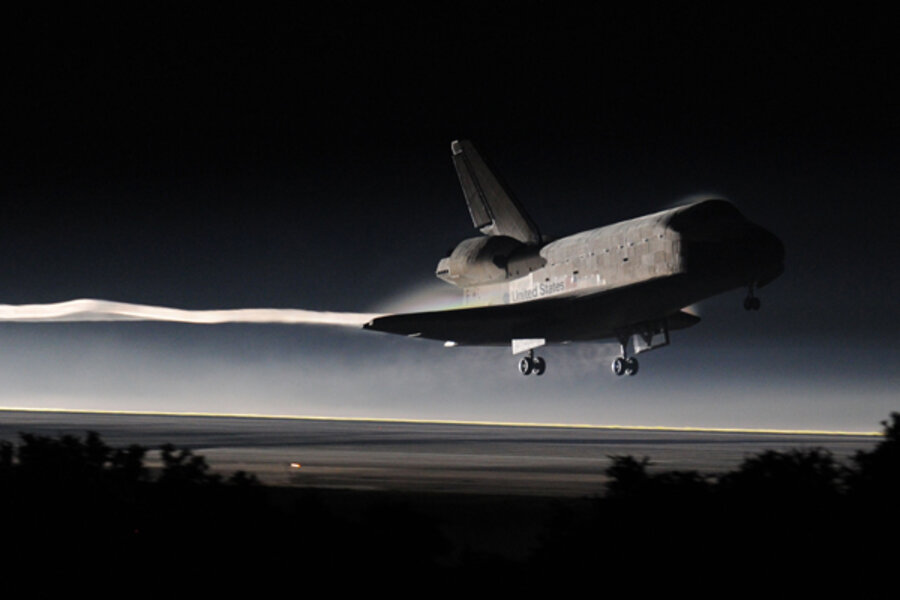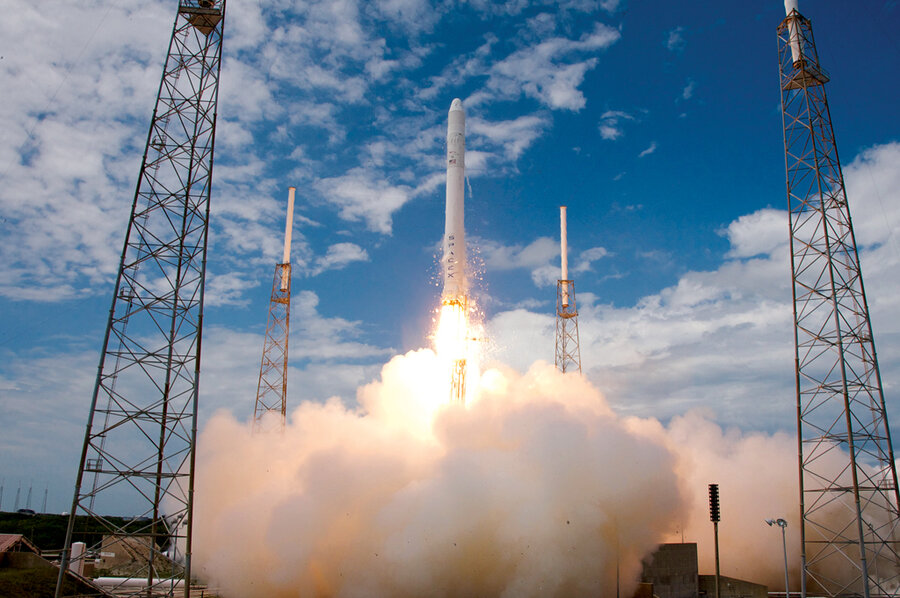With Atlantis landing, an era ends. Are private space firms ready for duty?
Loading...
With the National Aeronautics and Space Administration's space-shuttle program shifting from missions to memories, the US human spaceflight program is undergoing a historic change as the agency turns over its transport service to and from the space station to commercial rocketmakers and focuses instead on sending human explorers deeper into the solar system.
The shift from government venture to commercial carriers is a familiar, often uncomfortable, transition.
Historians note that transcontinental railroads initially required decades of subsidies because banks and business tycoons east of the Mississippi refused to invest in a venture for which they saw no obvious markets. Who lived in the "Great American Desert" and beyond, after all?
After World War I, passage of the Kelly Act – which required the US Post Office to begin shipping mail via privately operated airplanes – triggered the establishment and growth of airlines.
The commercial sector's emerging role in human spaceflight is following those historical patterns, proponents of the shift say. If private industry can achieve the goal of driving down the cost of reaching Earth orbit, the payoff could be just as significant over the long term as railroads or airplane travel – this time for sectors ranging from manufacturing to mining to energy.
"If we choose to take the right steps, there is every reason to believe that 10 years from now multiple private entities can be taking payloads and passengers on a for-profit basis to suborbital space and to orbital space," says Jeff Greason, cofounder and chief executive officer of XCOR Aerospace, based in Mojave, Calif., and a member of a panel President Obama appointed in 2009 to provide options for the US human-spaceflight program.
"And there's every reason to believe that 10 years from now there will be destinations to go to," he adds. Bigelow Aerospace in Las Vegas, he notes, is building and testing on-orbit habitat modules that can be joined to make structures ranging from orbiting hotels to small lab complexes that companies or governments can lease for research.
To be sure, not everyone is convinced.
Critics – including powerful members of Congress – counter that the changes at NASA are putting the agency's human-spaceflight eggs in a fragile basket, woven from companies that are largely untested. If this effort fails, NASA will be stuck buying ever-more-expensive seats on Russian rockets to get US astronauts to and from the station, at least through the end of the decade.
Moreover, business plans for these companies are based on shaky assumptions, critics say, often voicing skepticism as to whether markets really will emerge. Even some people excited about the transition say many unknowns remain.
"A lot of analysis is predicated on back-of-the-envelope thinking," says Roger Launius, former NASA historian and now senior curator in the space-history division of the Smithsonian Institution in Washington.
"That's not a bad thing," he continues. "A lot of innovation arises that way. But I've heard it a million times: If we just reduce the cost of payloads to orbit, these wonderful things can happen. They may be right and they may be wrong, but without some serious analysis identifying those 'wonderful things' and at what point they become viable," it's hard to gauge how realistic the hopes for commercial human spaceflight are.
Attracting capital is the challenging part of the space business at this stage, Mr. Greason says. "We don't have quite enough near-term demand to show that you would get at least a reasonable return on your investment, but we're getting close," he says.
Significantly, he says, when wealthy space tourist Richard Garriott traveled to the space station in 2008, he was able to offset the $30 million price tag by conducting research for which he was paid between $6 million and $7 million.
"Of course, that's less than the trip cost him," Greason says. But it suggests that if companies can drop the price of a ride into orbit to $5 million per person, he adds, "doing it would become profitable. You might get hundreds of people a year."
NASA is one source of near-term demand. If commercial providers can begin launching people to the space station by 2015, NASA would likely provide as much as 80 percent of that near-term demand – for perhaps the first five years or so of operation, says Bretton Alexander, who served in the White House Office of Science and Technology policy under Presidents Clinton and Bush and who now sits on NASA's Advisory Council. But he says he expects that proportion to drop as time passes and the market grows.
Who else would be interested? Foreign space agencies could want seats, he says, boosting demand for orbital flights beyond NASA's needs.
A top official from the European Space Agency recently told Mr. Alexander "that the commercial-crew program that NASA is pursuing means everything for ESA's human-spaceflight program," Alexander says. If US industry can put humans into space safely, reliably, and at a lower cost than either NASA or today's launch industry, it would provide ESA and European industry with new opportunities to give astronauts and industrial researchers more-frequent access to space.
Few see this happening overnight. The expectation is that space tourism and a small but growing lineup of research customers for suborbital flights will supplement NASA demand. Launch costs are expected to fall, gradually at first, as demand rises. Even then, costs are expected to be a bargain compared with the $1.5 billion NASA spent for each shuttle launch.
Some of the long-term possibilities for commercial human activities in space include producing purer pharmaceuticals, setting up refueling stations for satellites, and conducting more-comprehensive studies in space medicine in anticipation of settling other planets.
For now, however, NASA money means key aerospace players are focused on developing transportation for cargo and crew to the space station. The list includes well-established companies as well as some upstarts.
Under its commercial-cargo program, NASA has set up contracts for demonstration flights with nine-year-old Space Exploration Technologies in Hawthorne, Calif. SpaceX already has two launches of its Falcon 9 rocket under its belt, – including the first commercial launch, orbit, and retrieval of a space capsule.
It has two additional demonstration launches scheduled toward the end of the year. NASA officials suggest the objectives are likely to be merged into one launch.
In addition, last December SpaceX signed a $1.6 billion contract with NASA to ferry supplies to the space station. The first supply flight is scheduled for next year.
But for all the publicity, SpaceX has received for its successes so far, it's not the only player in the game. Orbital Sciences Corp., a 20-year-old company that has been lofting payloads for NASA and the Defense Department, has scheduled its own test launch, in addition to its first official demonstration launch under NASA's commercial-cargo program for the fourth quarter of this year.
The competition for crew transportation services is even more robust.
Earlier this year, NASA picked four companies to advance designs for craft or major components to carry crews to and from low-Earth orbit. The agency made a $269.3 million pot available, with payments made as each company meets specified milestones.
Boeing Co., with a long history in the space-hardware business, drew the lion's share of the money, garnering $92.3 million.
Sierra Nevada Corp. received $80 million for its "Dream Chaser," a reusable shuttlelike glider that can launch atop an Atlas V rocket. SpaceX is in line for $75 million as it aims to adjust its Falcon 9 and Dragon capsule for human use. And Blue Origin, set up by Amazon.com founder Jeff Bezos, is slated for $22 million.
In addition, on Monday NASA inked a deal with United Launch Alliance, a nine-year-old joint venture between Boeing and Lockheed Martin, to explore in detail the potential the ULA's Atlas V rocket has for lofting humans. The Atlas V has been launching NASA science missions and Pentagon payloads into orbit and beyond since 2002. If the Atlas V becomes part of commercial human-spaceflight's stable of rockets, it will mark a return home of sorts. Earlier versions of the Atlas rocket lofted four Mercury astronauts into orbit in the 1960s, including John Glenn, the first American to orbit Earth. Under the agreement, ULA receives no money from NASA. But it will receive technical support from the agency with an eye toward tailoring the rocket to meet NASA's crew-safety requirements.
In the end, the shift toward commercial ownership, as well as operation, of rockets carrying humans into orbit isn't just about how to replace the shuttle, says Alexander.
"Do we want to be in the same place 20 years from now, where governments worldwide are the only ones who can put people in space and we're flying tens of people a year? Or do we want hundreds of people a year going into space?"
[ Video is no longer available. ]






